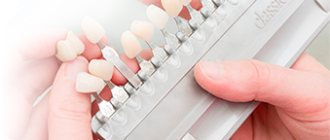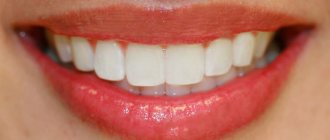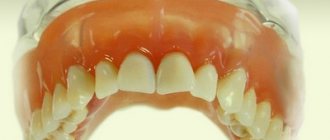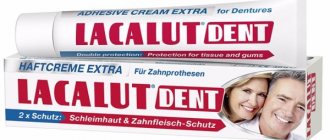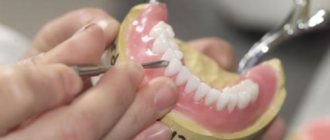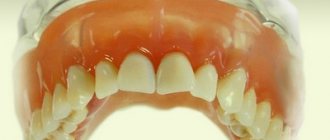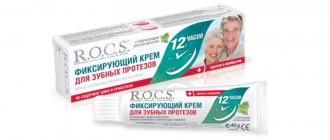Types of ceramic veneers
The classification of veneers is related to their manufacturing technologies.
Pressed veneers are made from dental porcelain. As a result, an ultra-thin plate is created, which is subsequently ground and glazed, which creates a pleasant natural shine. A similar technique is used to create ultra-thin E-max ceramic veneers.
Zirconium veneers are a separate type of ceramic veneers that are made from zirconium dioxide. The basis of the two-layer structure is a zirconium plate. A ceramic layer is applied to it. The zirconium frame provides extra strength.
Other benefits include:
• the shade does not change over time; • thickness of only 0.3 mm ensures invisibility; • does not cause allergies; • service life 20 years.
Not everyone can afford the price. This is the drawback.
A popular service at our clinic is the installation of feldspathic veneers. During their manufacture, the technician applies ceramics layer by layer, which is a precise, highly artistic work. The ceramic layers are no more than a fraction of a millimeter. During the specialist’s work, anthropometric data are taken into account. With their help, it is possible to present the overall picture of the dentition, the smile line, and plan the ideal shape of the structure. As a result, feldspathic veneers cannot be distinguished from natural teeth. .
Lumineers
The perfect (Hollywood) smile can be achieved with lumineers. The design of lumineers is slightly thinner than conventional veneers. The shape is similar to petals. To fix lumineers, veneer adhesive is used.
There are standard and individual lumineers. The former have a variety of colors and sizes. They are somewhat similar in installation to false nails. The latter are made in the laboratory depending on the individual characteristics of the patient.
Lumineers increase the volume of teeth. They are used in cases:
- Slight discoloration of teeth. The design of the devices is very thin (0.3 mm), translucent, so they cannot hide the obvious unevenness of color.
- Small diastemas between teeth. Lumineers cover them well.
- The presence of chips on the teeth and their concealment. Here, individual lumineers will be used, in which the thickness at the chip site should be greater.
- The appearance of cracks in the enamel that you want to hide.
Lumineers have a significant drawback, which manifests itself in a short service life due to low reliability. Broken material unfortunately cannot be repaired. Some procedures will need to be completed first.
A positive aspect of veneering is that the glue on which it is attached contains the element fluorine. Therefore, experts say that wearing such structures is beneficial for tooth enamel.
After installing the veneers, the dentist will invite the patient for a second appointment. This will happen in about a week. The doctor will examine your teeth and gums. He will look at how the teeth have adapted to the installed material. In addition, the doctor can perform the final steps to adjust the veneers. That is, after his manipulations, the mouth will look even better. Now it will be easier for the tooth and veneer to cope with their functions.
Manufacturing and installation
Ceramic veneers are installed after successive stages of work by a doctor at the ROCOSCLINIC clinic.
1. Consultation - a specialist finds out what aesthetic problems concern the client. The bite, defects, and enamel shade are taken into account. 2. The technician performs virtual modeling of teeth using a computer program. With the help of simple manipulations, thanks to mock-up technology, the formed volume of teeth helps to create temporary plastic structures. 3. Fitting, approval of the shape and color of the crown of the teeth. 4. Fixation of permanent ceramic restorations using a microscope ensures high precision.
Products are manufactured in our dental laboratory.
Reliable fixation of veneers
The onlays are fixed using a special strong dental glue, resulting in a monolithic “veneer + tooth” structure. The inner surface of the plates has roughness - for better adhesion to dental tissues. When preparing the enamel, the dentist will also create the necessary microrelief. Then the doctor treats the surfaces of the veneer and tooth with special preparations, applies glue and carefully fixes the veneer. If all the nuances of the technology are followed, there will be no problems with falling out veneers. High-quality micro-prostheses will last from 10 to 15 years or more.
How is a ceramic veneer different from a lumineer?
Ceramic veneers and lumineers are not the same thing. Lumineers are also dental coverings, only:
• veneers are thicker, so you have to grind off the enamel layer before installing them. In addition, at the junction of the gum and the attachment of the plate, after a while a small space may form where food debris will accumulate; • the warranty period for veneers is shorter; • veneers are cheaper than lumineers.
Lumineers have recently appeared. People often call them “Hollywood”, as they help create the snow-white smile of celebrities.
Veneers – what are they?
There are two types of veneers:
- Therapeutic. Veneers are made directly on the patient’s tooth. Their composition includes composite materials that are very similar to filling materials. Often such dental devices are used for chipping (in this case, the chipping area can occupy 60%). That is, the procedure can be considered as restoration or extension of a tooth. If we do not consider the case of chipping, then under other circumstances the teeth are ground down a little, a veneer is formed, then they are ground and polished.
- Orthopedic veneers, lumineers. These materials are manufactured in a laboratory environment. In this case, an impression of the patient’s teeth must be taken. They are glued to the tooth using glue specialized for these conditions.
Therapeutic veneers are affordable for many. The price of their installation ranges from 2,500 to 15,000 rubles. The cost threshold depends on the prestige of the clinic, the characteristics of the treatment and the materials used.
Orthopedic ones are much more expensive in price than therapeutic ones. The price starts from 15,000 and goes up to 50,000 rubles. The same factors influence the price here.
Caring for ceramic veneers
After ceramic veneers have been installed, you should not forget about the features of oral care.
1. It is necessary to avoid severe mechanical stress and consumption of solid food. All this can lead to damage to the product; 2. You cannot eat cold and hot foods at the same time. Alternating contrasting temperature conditions can cause the ceramic veneer to crack. 3. There is no need to use pastes containing abrasive substances, otherwise the ceramics are subject to microcracks. It is in them that coloring substances accumulate, which over time spoil the appearance of the veneers. 4. You should pay attention to your toothbrush. Her bristles should be soft. To treat the surface of teeth not covered with veneers, you can use a brush with medium hardness. Vibrating brushes can promote peeling of records, so the choice should be in favor of simple ones. 5. It is necessary to include the use of an irrigator into a healthy habit. A stream of water removes food between the teeth where the brush did not reach; micromassage exerts pressure on the gums. All this has a beneficial effect on gum health.
It makes sense to regularly visit the dentist of the ROCOSCLINIC clinic in order to promptly eliminate problems and carry out professional hygiene.
Despite the strength of the structure, it is necessary to adhere to these recommendations. Ceramic veneers will last longer and look better if you take proper care of your mouth.
Stages of making ceramic veneers
1. Preparatory
At this stage, the oral cavity is sanitized, teeth are professionally cleaned, and a step-by-step treatment plan is developed.
2. Smile analysis
The doctor takes photographs of the patient from several angles while he is smiling. If necessary, gum correction and other manipulations are performed.
3. Color selection
Modern materials from which veneers are made have all the properties of natural enamel. And she is translucent. Therefore, when choosing a color, it is important to realize that your own tooth tissue will influence the final result. Color is determined using traditional scales or special devices. The latter scan the enamel color at several points, process the information and produce the result. The advantage is that artificial intelligence does not have its own opinion and color perception, the result is impartial. The downside is that the cost of the procedure is too high. Therefore, color is most often determined using a proven method - using a color scale.
4. Preparation
If you place veneers directly on the teeth, they will turn out to be too thick, and the plate will not fit tightly to the gum. Therefore, the teeth are prepared - the top layer of enamel is removed to the thickness of the product. This is 0.2-0.5 mm. The neck has a smaller layer of enamel, and it is important to preserve it for good adhesion. At the edge, the layer is thicker. It is important for the doctor to remove just such a layer of enamel in order to maintain adhesion and give the tooth a natural appearance.
After preparation, the patient is fitted with temporary veneers. They are a block construction made of plastic. Real veneers are bonded to each tooth individually.
5. Taking impressions
It all depends on the level of equipment of the clinic. Premium dental centers use computer scanning. In clinics it’s simpler - they make silicone impressions. The impressions are then sent to the laboratory.
6. Making veneers
It all starts with a plaster model. Anatomical accuracy and appearance depend on the skill of the technician. The interaction between the technician and the dentist is very important. The end result is better in clinics with their own technical laboratory, where the doctor and technician work as one team. After the plaster model comes the turn of the wax model. It is filled with a refractory mass and placed in the oven. The wax evaporates under the influence of heat, leaving cavities. They are filled with ceramics and placed back in the kiln. Then the mold is cut, the veneer is processed, and fitted onto a plaster jaw. In the final step, the technician applies the glaze by hand. Then back into the oven. This is a hot pressing method.
In layer-by-layer application, ceramics are applied in layers, each time being fired in a kiln. On a milling machine, the veneer is cut out from a blank. Automation manages the process. Then ceramics are applied to the frame.
7. Trying on
Regardless of how veneers are applied to teeth, they are tried on in the same way. During the fitting, veneers are not glued to permanent cement, but are fixed only to see how they look. If there are any shortcomings, they will be corrected in the laboratory.
8. Fixation
The doctor etches the veneer and tooth enamel with acid to create a rough surface. Dental cement is then applied and each veneer is secured individually.
The whole process takes about 2-3 weeks
, sometimes less. The timing also depends on whether the clinic has its own laboratory or has to outsource it to a contractor.
Where is the ROCOSCLINIC clinic located?
Moscow is a city where you can get any dental service, one of which includes the installation of ceramic veneers. Call us, sign up for a consultation and we will be happy to consider your problem related to the aesthetic unattractiveness of your teeth.
The task of doctors is not only to treat, but also to restore the beauty of a smile. And it works out well. See for yourself. We know how to make your smile radiant and charming.
We are waiting for you at the address: Moscow, 17-Maryina Roshchi pr-d, no. 1.
Indications for installation
Installation of veneers on the front teeth is required to correct the following problems:
- Hue.
If your teeth have turned yellow or darkened, it is not always possible to return them to their natural shade with whitening. Installing veneers allows you to regain your beautiful smile without the use of dangerous whitening chemicals. The same applies to solving the problem of tetracycline teeth. - Cracks.
A crack or chip of tooth enamel is a direct path to the formation of caries and further tooth destruction. The best way to get rid of the problem forever is to use a dental veneer. - Interdental gaps.
Many people experience psychological discomfort due to the fact that the teeth in a row are located at unequal distances from each other. Veneers will help avoid radical treatment with braces and visually correct gaps. - Defects.
Onlays can hide a number of dental defects: short teeth, enamel hypoplasia, wedge-shaped defect, small curvatures, gummy smile (in combination with gum surgery).
Veneers can be placed not only on the front teeth, but also on the side teeth. This little trick will give your face a lifting effect. In Russia, such a procedure is still rare, but in the West it is very popular.
Temporary veneers have disadvantages:
- Loose fit, as a result of which saliva penetrates under them;
- Lack of strong fixation;
- A simplified form that differs significantly from the form of permanent, laboratory-made veneers.
- They have the property of being painted, they quickly fail.
They cannot be used for a long time, but temporary veneers perform their main function of protecting the tooth from harmful influences until permanent structures are installed.
During the short period of time the permanent veneers are being made, the enamel will not stain.
Proper installation of temporary veneers provides the patient with the opportunity to talk and smile without embarrassment or worry about the impression they make.
“Veneers destroy teeth”
Veneers are actually installed on previously ground teeth, just like metal-ceramic crowns. But the facts confirming their destructive effect are not enough to draw clear conclusions. Moreover, before installing ceramic plates, the dentist must examine the supporting teeth and make sure that there are no caries or other pathologies of the oral cavity. As a result, the likelihood of destruction of healthy teeth under veneers is reduced to zero, because they are sealed and protect the tooth from plaque and lactic acid. The development of caries is also prevented by the special cement with which veneers are fixed.
The use of veneers for problems with orthodontics in a patient
When can you avoid orthodontic treatment when installing veneers? The question is important and relevant, since veneers can easily hide almost any visual defect in the curvature of teeth. Installation of veneers in case of malocclusion is possible if the alignment of the teeth is not severely disturbed. It is impossible to describe this in words, since you always need to see “live” each specific smile. But if the alignment of the teeth is disturbed by no more than 2-3, and sometimes 4 mm, then it is possible to get by only with veneers and get an absolutely even and beautiful smile. Yes, this is quite possible.
In what cases is orthodontic treatment necessary?
There are a large number of malocclusions for which the installation of veneers is contraindicated
, for example:
- deep bite,
- crossbite,
- excessively large gaps between teeth, more than 4 mm,
- as well as pronounced crowding of teeth.
All these issues are discussed during the consultation.
Author's veneers at NKclinic
Few people in the modern world can say that they are satisfied with their natural smile. Some defects, such as malocclusion and underdeveloped teeth, are congenital. During life, teeth are also exposed to negative environmental influences, including harmful industries, injuries and bad habits, which can lead to cracks, chips, and slight discoloration. Incorrect bite, without timely orthodontic correction, leads to increased tooth wear, which is a direct indication for reconstructive orthopedic dentistry.
For NKclinic specialists, making veneers is a responsible as well as creative process. At the same time, the finished product is inimitable and unique. Despite the large-scale introduction of digital technologies, doctors at our center exclude the use of template, standardized methods for manufacturing ceramic structures.
At NKclinic, the main principle of the work of the chief physician, Grigory Georgievich Kyalov, is to create teeth of natural beauty, taking into account the optical properties of hard dental tissues: light transmittance, brightness, transitional shades of color, like natural teeth. This makes it possible to emphasize your individuality, place the right accents and add charm to your smile.
The key to achieving maximum aesthetic results is individualized, multidisciplinary treatment planning. Often, in addition to the orthopedic stage, the patient needs surgical correction of the gingival margin, which allows the formation of the correct gingival contour. Get proper periodontal care.
Aesthetic and functional analysis of the dental system as a whole consists of a comprehensive study of each clinical case individually. This takes into account the structural features of the skull, the trajectory of the lower jaw, as well as facial features.
To achieve the most predictable and accurate results, we use digital technologies in combination with the practical and clinical experience and knowledge of our center’s professionals.
Orthopedic treatment planning:
- Medical photography to assess the aesthetic parameters of the patient’s face and determine individual anthropometric data.
- Creating 3D photographs of a face.
- Digital scanning, which, in combination with the manual skill of the doctor, allows you to obtain highly accurate three-dimensional digital models of the jaws and bite in a matter of minutes.
- 3D modeling makes it possible to compare medical photographs of a patient with digital models of the jaws, combined with computed tomography and 3D photography to predict the outcome.
- Digital modeling of teeth according to the patient's smile to achieve facial harmonization. The use of a virtual articulator allows you to build a physiologically correct bite.
- Making a 3D model on a 3D printer.
After this, our doctors make a mockup, i.e. transfer of a prototype of future orthopedic structures into the oral cavity.
At this stage, the design of future teeth is agreed upon with the patient, namely the color, shape, size and other nuances of the future smile.
This layout allows the orthopedist to prepare the teeth in such a way as to correctly convey the optical effects for maximum naturalness of the smile, as well as to easily install the ceramic structure in the oral cavity at the fixation stage, while maintaining the maximum thickness of the natural tooth tissues. Kyalov Grigory Georgievich individually selects materials for each specific case. Our goal is not to sell the most expensive technology. We work for high results and select the best solution for our patients.
Ceramic veneers are made from sintered ceramics, which has maximum aesthetic properties close to the properties of natural tooth enamel, therefore an important condition is the preservation of the enamel layer of the tooth.
NKclinic doctors work at the intersection of scientific and practical dentistry and art. Our approach will certainly be appreciated by people who want to achieve a truly unique smile.
An important point when installing veneers
For me, as a specialist installing veneers, it is important to understand the patient’s inner world - because the aesthetic result when installing veneers must fully correspond and harmonize with the patient.
Therefore, we can discuss the following questions:
- in what circle of people does he communicate?
- working or housewife
- together with the patient we try to understand his true desire,
- I study the medical history, past and concomitant diseases, allergic reactions to medications,
- I conduct a 3D scan or make dental impressions,
- Ideally, you need to bring with you or have a computed tomography scan done at the Cerecon clinic to see if all your teeth are completely healthy, since sometimes inflammation in the root area is possible.
By the way, my veneers perfectly hide the defect of crooked teeth:
Next, there is an examination, fitting of different colors of future veneers; at the patient’s request, we can schedule a mock up for the next visit, that is, fitting of veneers made of composite plastic. If the patient wants to see his future smile with veneers, then I submit an order to the technical laboratory to make a mock-up.
Next, the patient and I sit down at the computer and begin to look at examples of my work on veneers.
In this way, I introduce the patient to dentistry as a science so that he is on the same wavelength with me. Once again we discuss the issue of the number of visits, the time spent by the patient on installing the required number of veneers, we talk with the patient about the processes accompanying the installation of veneers, and so on.
During the consultation process, we also touch upon the patient’s financial preferences. If the patient doesn’t mind, I take a photo protocol - professional dental photos,
on the basis of which, together with the patient, we analyze his smile in detail on a large monitor with an IPS matrix: such a computer display is capable of conveying absolutely all natural shades of teeth.
Why do I ask the patient about work?
In principle, now there is no longer any dependence at all on the installation of veneers on the patient’s field of activity. If previously veneers were installed mainly only by those who are shown on screens, now absolutely all groups of professions want a Hollywood smile.
But most often my patients are people who don’t just sit at home, but go out into the world, who often communicate with people. Also very often girls who want to get married come to me. In other words, now absolutely everyone wants beautiful veneers. It happens that everything just comes down to money.
The question “where does the patient work” is not an idle one, it remains useful for me, as a professional in the installation of veneers, because veneers can be given both an element of business activity for working in a business environment, and the charming charm of a housewife. It all depends on the patient’s wishes, which we find out during the consultation.
Why is a mock up sometimes important for a patient?
Even before grinding the teeth, at the patient’s request, he is given a fitting of veneers made of composite plastic. Mock-up on veneers is possible only if the patient has relatively straight teeth with a curvature of no more than 2 mm in individual teeth. The mock-up is made from a special material, which consists of a plastic composite, is applied directly to the natural teeth and will look ideal when the plastic complements the teeth, for example, when they are worn out, and not applied to crooked teeth.
How a patient's smile is analyzed
“We analyze the patient’s smile” - this means “we examine the patient’s smile and face” together with him on the monitor screen:
- We note the correct proportions of the face,
- We reveal the width of the maximum smile.
- determine facial expression when smiling,
- pay attention to the bite.
Where to install temporary veneers
In the network of family dental clinics ILATAN.
- Here, experienced professionals will take care of your dental health.
- The most comfortable treatment is ensured by a caring attitude and the most modern equipment.
- To work with clients, ILATAN uses only high-quality materials.
- Temporary veneers installed in our clinics have a natural appearance.
- You can be in public places with them, laugh and smile calmly, without worrying about the appearance of your teeth.
